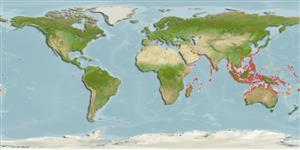Classification / Names
ຊື່ສາມັນ | ຄຳສັບຄ້າຍຄືກັນ | Catalog of Fishes(ຕະກຸນ, ຊະນິດ) | ITIS | CoL | WoRMS | Cloffa
>
Clupeiformes (Herrings) >
Engraulidae (Anchovies) > Engraulinae
Etymology: Encrasicholina: Greek, egkrasicholos, -os, -on = mixed with spleen.
More on author: Whitley.
Environment: milieu / climate zone / depth range / distribution range
ນິເວດວິທະຍາ
ສັດທະເລ; ນ້ຳກ່ອຍ ກ່ຽວກັນຫີນ. Tropical; 32°N - 28°S, 43°E - 173°W (Ref. 189)
Indo-Pacific: widespread in the northern part of the Indian Ocean (Gulf of Aden, but apparently not the Red Sea nor Kenya, the Persian Gulf, India, Andaman Islands) and Western Central Pacific (Indonesia, Thailand, north to at least Taiwan Island, south to northern Australia; also eastward to Fiji and Tonga).
Length at first maturity / ຂະໜາດ / ນ້ຳໜັກ / Age
Maturity: Lm 6.1, range 4 - ? cm
Max length : 9.7 cm TL ຕົວຜູ້/ບໍ່ມີເພດ; (Ref. 55634); 10.0 cm TL (female); ນ້ຳໜັກສູງສຸດທີ່ເຄຍຈັດພີມມາ: 8.00 g (Ref. 55634); ນ້ຳໜັກສູງສຸດທີ່ເຄຍຈັດພີມມາ: 8.00 g
ຄີ(ໜາມ) ແຂງຢູ່ຄີກົ້ນປາ
ກຸ່ມປາກະດູກແຂງ
ຄວາມຖີ່ຂອງກຸ່ມຖ່າຍທອດພັນ
ປາທີ່ມີການເຄື່ອນຍ້າຍຈາກທະເລໄປຫານ້ຳຈືດ ແລະນ້ຳຈືດຫາທະເລ
ປາທີ່ມີການເຄື່ອນຍ້າຍຈາກທະເລແລະໄປໄຂ່ຢູ່ນ້ຳຈືດ
ຄີກົ້ນຂອງປາ
ສັດທີ່ມີກະດູກສັນຫັຼງ
ການຖ່າຍທອດທາງກຳມະພັນຈາກພໍ່ແມ່ຫາລູກ 0; ຄີກົ້ນຂອງປາ: 18 - 20. Diagnosis: Body rather cylindrical, belly rounded, with 5-6, rarely 3 or 4, sharp needle-like pre-pelvic scutes; maxilla tip pointed, projecting beyond second supra-maxilla and reaching to sub-operculum; isthmus short, preceded by a small bony plate on urohyal between branchial membranes; lower gillrakers 20-27; unbranched dorsal and anal finrays 3, anal fin short, with usually 15-17 branched finrays; in life, a bright silver band on flank, with a thin blue line above, back blue/grey (Ref. 189). It closely resembles Encrasicholina heteroloba, which has only 2 unbranched dorsal and anal finrays, a dull silver/grey band on flank, and the back beige; Encrasicholina oligobranchus has only 17-18 gillrakers; other species of Encrasicholina have a fleshy urohyal plate and a maxilla tip blunt and not projecting beyond the second supra-maxilla; species of Stolephorus have a long isthmus reaching to the margin of the branchial membrane (Ref. 189).
Whitehead, P.J.P., G.J. Nelson and T. Wongratana, 1988. FAO Species Catalogue. Vol. 7. Clupeoid fishes of the world (Suborder Clupeoidei). An annotated and illustrated catalogue of the herrings, sardines, pilchards, sprats, shads, anchovies and wolf-herrings. FAO Fish. Synop. 125(7/2):305-579. Rome: FAO. (Ref. 189)
IUCN Red List Status (Ref. 130435)
Threat to humans
Harmless
Human uses
ການປະມົງ: ທີ່ເປັນການຄ້າໜ້ອຍ; ເຍື່ອ: usually
ຂໍ້ມູນຕື່ມອີກ
ເອກະສານອ້າງອີງການລ້ຽງສັດນ້ຳຂໍ້ມູນການລ້ຽງສັດນ້ຳສາຍພັນກຳມະພັນElectrophoresesການຖ່າຍທອດທາງກຳມະພັນຈາກພໍ່ແມ່ຫາລູກພະຍາດການປຸງແຕ່ງNutrientsMass conversion
ຜູ້ຮ່ວມມືຮູບStamps, Coins Misc.ສຽງຫອຍມີພິດຊະນິດນຶ່ງທີ່ອາໄສໃນທະເລຄວາມໄວປະເພດການລອຍເນື້ອທີ່ເຫືອກOtolithsສະໝອງວິໄສທັດ
ເຄື່ອງມື
Special reports
Download XML
ແຫຼ່ງອີນເຕີເນັດ
Estimates based on models
Preferred temperature (Ref.
123201): 25.1 - 29.3, mean 28.5 °C (based on 3195 cells).
Phylogenetic diversity index (Ref.
82804): PD
50 = 0.5039 [Uniqueness, from 0.5 = low to 2.0 = high].
Bayesian length-weight: a=0.00550 (0.00464 - 0.00651), b=3.12 (3.08 - 3.16), in cm total length, based on LWR estimates for this species (Ref.
93245).
ຊັ້ນເຂດຮ້ອນ (Ref.
69278): 3.3 ±0.1 se; based on diet studies.
ຄວາມຢືດຢຸ່ນ (Ref.
120179): ສູງ, ປະຊາກອນຕຳ່ສຸດທີ່ໃຊ້ເວລາສອງໜ້ອຍກວ່າ 15 ເດືອນ (K=2.00-5.04; tm=0.29; tmax=1.7).
Prior r = 1.19, 95% CL = 0.79 - 1.79, Based on 1 stock assessment.
Fishing Vulnerability (Ref.
59153): Low vulnerability (10 of 100).
Nutrients (Ref.
124155): Calcium = 239 [65, 779] mg/100g; Iron = 1.47 [0.53, 3.85] mg/100g; Protein = 19.7 [17.2, 21.8] %; Omega3 = 0.207 [0.089, 0.481] g/100g; Selenium = 39.9 [12.9, 127.6] μg/100g; VitaminA = 37.5 [9.1, 191.7] μg/100g; Zinc = 2.21 [1.24, 5.33] mg/100g (wet weight); based on
nutrient studies.
